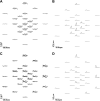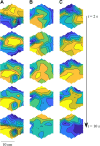Multichannel magnetogastrogram: a clinical marker for pediatric chronic nausea
- PMID: 36255075
- PMCID: PMC9678406
- DOI: 10.1152/ajpgi.00158.2022
Multichannel magnetogastrogram: a clinical marker for pediatric chronic nausea
Abstract
Chronic nausea is a widespread functional disease in children with numerous comorbidities. High-resolution electrogastrogram (HR-EGG) has shown sufficient sensitivity as a noninvasive clinical marker to objectively detect distinct gastric slow wave properties in children with functional nausea. We hypothesized that the increased precision of magnetogastrogram (MGG) slow wave recordings could provide supplementary information not evident on HR-EGG. We evaluated simultaneous pre- and postprandial MGG and HR-EGG recordings in pediatric patients with chronic nausea and healthy asymptomatic subjects, while also measuring nausea intensity and nausea severity. We found significant reductions in postprandial dominant frequency and normogastric power, and higher levels of postprandial bradygastric power in patients with nausea in both MGG and HR-EGG. MGG also detected significantly lower preprandial normogastric power in patients. A significant difference in the mean preprandial gastric slow wave propagation direction was observed in patients as compared with controls in both MGG (control: 180 ± 61°, patient: 34 ±72°; P < 0.05) and HR-EGG (control: 240 ± 39°, patient: 180 ± 46°; P < 0.05). Patients also showed a significant change in the mean slow wave direction between pre- and postprandial periods in MGG (P < 0.05). No statistical differences were observed in propagation speed between healthy subjects and patients in either MGG or HR-EGG pre/postprandial periods. The use of MGG and/or HR-EGG represents an opportunity to assess noninvasively the effects of chronic nausea on gastric slow wave activity. MGG data may offer the opportunity for further refinement of the more portable and economical HR-EGG in future machine-learning approaches for functional nausea.NEW & NOTEWORTHY Pediatric chronic nausea is a difficult-to-measure subjective complaint that requires objective diagnosis, clinical assessment, and individualized treatment plans. Our study demonstrates that multichannel MGG used in conjunction with custom HR-EGG detects key pathological signatures of functional nausea in children. This quantifiable measure may allow more personalized diagnosis and treatment in addition to minimizing the cost and potential radiation associated with current diagnostic approaches.
Keywords: chronic nausea; gastric slow wave; magnetogastrogram; pediatric.
Conflict of interest statement
No conflicts of interest, financial or otherwise, are declared by the authors.
Figures







References
-
- Camilleri M, Dubois D, Coulie B, Jones M, Kahrilas PJ, Rentz AM, Sonnenberg A, Stanghellini V, Stewart WF, Tack J, Talley NJ, Whitehead W, Revicki DA. Prevalence and socioeconomic impact of upper gastrointestinal disorders in the United States: results of the US upper gastrointestinal study. Clin Gastroenterol Hepatol 3: 543–552, 2005. doi:10.1016/s1542-3565(05)00153-9. - DOI - PubMed
-
- Parkman HP, Camilleri M, Farrugia G, McCallum RW, Bharucha AE, Mayer EA, Tack JF, Spiller R, Horowitz M, Vinik AI, Galligan JJ, Pasricha PJ, Kuo B, Szarka LA, Marciani L, Jones K, Parrish CR, Sandroni P, Abell T, Ordog T, Hasler W, Koch KL, Sanders K, Norton NJ, Hamilton F. Gastroparesis and functional dyspepsia: excerpts from the AGA/ANMS meeting. Neurogastroenterol Motil 22: 113–133, 2010. doi:10.1111/j.1365-2982.2009.01434.x. - DOI - PMC - PubMed
Publication types
MeSH terms
Substances
Grants and funding
LinkOut - more resources
Full Text Sources

